Earlier this month the People’s Liberation Army (PLA) tested the use of a civilian heavy lift ship as a floating landing pad for Army helicopters.
PLA attack and transport helicopters landed on a semi-submersible heavy lift vessel, the Zhen Hua 28, whose deck was marked off into three landing areas. Ships like the Zhen Hua 28 flood ballast tanks to partially sink so that large marine cargoes like smaller vessels or oil rigs can be floated on and off their low, flat cargo deck.
A variety of laws give the PLA the authority to utilize civilian vessels for national defense purposes. The 2016 National Defense Transportation Law both clarified that authority and set standards for Chinese non-state-owned companies to ensure ships and other transportation infrastructure meet requirements for potential military use in a conflict.
But this recent aviation training goes a step beyond the logistical support and transportation missions implied in those laws to potentially using civilian ships to conduct combat operations. A Chinese military analyst explained that heavy lift ships like the Zhen Hua 28 might be used “to temporarily serve as a platform to carry helicopters, an offshore parking apron, and replenishment and repair center when performing some tasks in offshore areas, especially those with air domination.”
The analyst continued: “If missions are performed around large islands or reefs, a large semi-submersible ship can also be deployed at each end of the islands or reefs as maritime relay platforms to further enhance the cross-sea combat capability of the helicopters and to increase the helicopters’ combat radius.”
Utilizing relatively cheap, multipurpose unarmed platforms like lift ships to support combat aviation operations not only extends the reach of military helicopters but frees armed warships like the PLA Navy’s new Type 075 amphibious assault ships to conduct more dangerous missions.
Peter Dutton, a professor at the U.S. Naval War College and expert in maritime strategy and international law, noted on Twitter that these commercial vessels’ use for military purposes and potential participation in combat operations creates dangerous ambiguity about their protected status in combat. If they participate in combat operations, such as acting as a floating airfield for military aircraft, then they are legally targetable, but China is also obligated to make their military character clear so that they can be distinguished from non-military vessels. Failing to do so could lead to the mistaken or unnecessary targeting of protected civilian vessels during a conflict.
The U.S. Navy has been developing low-cost heavy lift capabilities for several years, beginning with two Expeditionary Dock Ships that are essentially giant floating flatbed trucks that can flood tanks to sit lower in the water, enabling U.S. Navy Landing Craft, Air Cushion – amphibious hovercraft – to float on and off, and to stage other heavy equipment to support amphibious operations. The U.S. Navy later built several heavily modified versions called Expeditionary Sea Bases that don’t submerge but had additional decks and spaces added to support helicopters, special operations forces, minesweeping, and other specialized missions.
Notably, the Expeditionary Sea Bases are all “grey hull” vessels, painted grey to denote their role in naval combat support as opposed to the purely logistical missions of the Expeditionary Dock Ships. The U.S. Navy recently decided to commission all of its expeditionary sea base ships, which were built as civilian-run naval auxiliaries, as warships with blended military and civilian crews under the command of a naval officer. Their “USS” designation makes them legally able to conduct combat operations with aircraft and embarked special operations forces as opposed to providing only combat support.
































